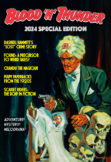EDitorial Comments
Reading Room: THE BLACK GANG
Herman Cyril “Sapper” McNeile, a British military engineer who saw combat during the First World War, turned to writing after the conflict and in 1920 began chronicling the exploits of one Hugh “Bulldog” Drummond, who would become one of pop culture’s most enduring heroes. Perhaps an idealized version of his creator, Drummond was the first of fiction’s many well-to-do WWI vets who, having become accustomed to action and danger during the War, found themselves bored and listless after returning to civilian life.
Like most vigilante heroes, Drummond is an unapologetic patriot with immense respect for the established order but equally immense impatience with the niceties of law enforcement and British jurisprudence. He’s inclined to favor direct action over legal wrangling and sees no problem in killing ruthless villains without due process. A born leader, he has gathered around him a group of like-minded friends—most of them also veterans of the Great War—who cheerfully match their wits and courage against a succession of crooks, traitors, and Bolsheviks operating to bring down Mother England. Drummond’s nemesis is the arch-criminal Carl Peterson, whom he bests for the first time in Bulldog Drummond, a 1920 novel received with equal enthusiasm on both sides of the Atlantic.
The second Drummond-Peterson bout takes place in The Black Gang, second novel of the series, published in the U.S. by Doran in 1922. This time around the action takes a pulpy turn. Although the British government privately applauds the work of Drummond and his cohorts, Scotland Yard takes a dim view of their activities. To safeguard their identities and thus guard against arrest and prosecution, Bulldog and his buddies begin wearing black masks and cloaks as they dash around the countryside. In addition to foiling Peterson’s plans, the black-clad vigilantes have taken to scooping up assorted malefactors and imprisoning them on a remote island off the coast of England. (Pulp fans will note that this predates similar practices later employed by The Shadow and Doc Savage.)
Peterson does not take kindly to this decimation of his ranks and strikes back by kidnapping Bulldog’s wife Phyllis. (Genius of crime that he is, Carl has quickly tumbled to the identity of the Black Gang’s leader.) But Drummond is one of those blokes who’s always at his best when things look worst, and this time is no exception.
I enjoyed The Black Gang a great deal. McNeile’s prose is clean-cut and vigorous, with a total lack of pretension or artifice. He’s a gifted storyteller whose defining trait is continuous forward motion, which is why his later novels were almost exclusively published in pulp magazines before appearing between hard covers. (Bulldog’s adventures splashed across the pages of The Popular Magazine, Detective Fiction Weekly, Mystery Novels Magazine, and Popular Detective.) His only failing is one not uncommon to Brits of a certain age and class: a clear disdain—if not outright hatred—for certain racial, ethnic, and religious groups deemed undesirable in early 20th century England. Russians and Italians are singled out for harsh treatment in The Black Gang, although Jews also take considerable abuse at the hands of Drummond and his compatriots. For this reason some people today find McNeile unreadable, but while such casual bigotry is grating to modern-day sensibilities, I’ve learned to read past the offending language and accept it as reflective of attitudes from a different time and place.
The Black Gang was adapted to the silver screen in 1934 as The Return of Bulldog Drummond, a British production starring Ralph Richardson in the title role. Although Richardson was an odd choice for the role, the movie is great fun—kind of like a 12-chapter serial boiled down to a 65-minute feature film.
Recent Posts
- Windy City Film Program: Day Two
- Windy City Pulp Show: Film Program
- Now Available: When Dracula Met Frankenstein
- Collectibles Section Update
- Mark Halegua (1953-2020), R.I.P.
Archives
- March 2023
- July 2021
- May 2021
- March 2020
- February 2020
- December 2019
- November 2019
- October 2019
- September 2019
- August 2019
- May 2019
- April 2019
- March 2019
- February 2019
- December 2018
- November 2018
- October 2018
- August 2018
- June 2018
- February 2018
- December 2017
- October 2017
- September 2017
- August 2017
- May 2017
- April 2017
- February 2017
- September 2016
- August 2016
- July 2016
- June 2016
- November 2015
- October 2015
- September 2015
- August 2015
- July 2015
- June 2015
- May 2015
- April 2015
- March 2015
- February 2015
- January 2015
- August 2014
- July 2014
- June 2014
- May 2014
- April 2014
- January 2014
- December 2013
- September 2013
- August 2013
- July 2013
- June 2013
- May 2013
- April 2013
- March 2013
- February 2013
- January 2013
- December 2012
- October 2012
- September 2012
- August 2012
- July 2012
- June 2012
- May 2012
Categories
- Birthday
- Blood 'n' Thunder
- Blood 'n' Thunder Presents
- Classic Pulp Reprints
- Collectibles For Sale
- Conventions
- Dime Novels
- Film Program
- Forgotten Classics of Pulp Fiction
- Movies
- Murania Press
- Pulp People
- PulpFest
- Pulps
- Reading Room
- Recently Read
- Serials
- Special Events
- Special Sale
- The Johnston McCulley Collection
- Uncategorized
- Upcoming Books
- Western Movies
- Windy City pulp convention
Dealers
Events
Publishers
Resources
- Coming Attractions
- Field Guide to Wild American Pulp Artists
- MagazineArt.Org
- Mystery*File
- ThePulp.Net





